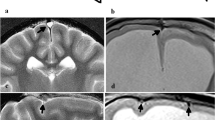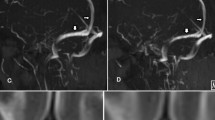Abstract
Fifty hydrocephalic children have been treated during the past 2 years by shunting the cerebrospinal fluid (CSF) to the internal jugular vein (IJV) against the direction of blood flow. Shunting the CSF in this way prevents the development of siphonage in the erect posture and regulates the intraventricular pressure (IVP) within normal limits. Most of the commonly encountered complications with current extracranial shunts did not occur. The ventriculomegaly regressed in patients with rigid craniums. The enormously enlarged head was reduced in size as a result of surgery in five infants. A shunting catheter with a simple unidirectional valve was used to establish the ventriculovenous (VV) connection. Shuntography was done on two patients.
Similar content being viewed by others
References
Anderson FM (1952) Subdural haematoma, a complication of operation for hydrocephalus. Pediatrics 10:11–18
Andersson H (1966) Craniosynostosis as a complication after operation for hydrocephalus. Acta Paediatr Scand 55:192–196
Becker CP, Nulsen FE (1968) Control of hydrocephalus by valve regulated venous shunt: avoidance of complications in prolonged shunt maintenance. J Neurosurg 28:215–226
Cushing H (1926) Studies in intracranial physiology and surgery. Oxford University Press, London
Davidoff LM, Feiring EH (1953) Subdural haematoma occurring in surgically treated hydrocephalic children with a note on a method of handling persistent accumulations. J Neurosurg 10:557–563
Davson H (1967) The cerebrospinal fluid pressure. In: Davson H (ed) Physiology of the CSF. Churchill Livingstone, London, pp 337–382
Emery JL, Hilton HB (1961) Lung and heart complications of the treatment of hydrocephalus by ventriculo-auriculostomy. Surgery 50:309–314
Enderlen (1911) Zur Behandlung des Hydrocephalus. Beitr Klin Chir 76:889–890
Erdohazi M, Eckstein HB, Crome L (1966) Pulmonary embolization as a complication of ventriculo-atrial shunts inserted for hydrocephalus. Dev Med Child Neurol [Suppl] 11:36–44
Foltz EL (1966) The first seven years of a hydrocephalus project. In: Shulman K (ed) Workshop in hydrocephalus. University of Pennsylvania Press, Philadelphia
Foltz EL, Shurtleff DB (1966) Conversion of communicating hydrocephalus to stenosis or occlusion of the aqueduct during ventricular shunt. J Neurosurg 24:520–529
Forrest DM, Cooper DGW (1968) Complications of ventriculo-atrial shunts; a review of 455 cases. J Neurosurg 29:506–512
Fox JL, McCullough DC, Green RC (1973) Alterations in CSF pressures following insertion of CSF shunts for hydrocephalus. 5th International Congress of Neurological Surgery, Tokyo
Fox JL, McCullough DC, Green RC (1973) Effect of CSF shunt on ICP and CSF dynamics. II. A new technique of pressure measurement, results and concepts. J Neurol Neurosurg Psychiatry 30:302–312
Fox JL, Portnoy HD, Shulte RR (1973) Cerebrospinal fluid shunts: an experimental evaluation of flow rates and pressure values in the anti-siphon valve. J Surg Neurol 1:299–302
Haynes IS (1913) Congenital internal hydrocephalus. Its treatment by drainage of the cisterna magna into the cranial sinuses. Ann Surg 57:449–484
Haynes IS (1915) Hydrocephalus — later experiences in its treatment by cisterna drainage. Med Rev NY 87:751–522
Haynes IS: Further experience in the treatment of hydrocephalus by cisterna sinus drainage (author's operation). State J Med NY 16:174–181
Horwitz NH, Rizzoli HV (1967) Postoperative complications in neurosurgical practice: recognition, prevention and management. Williams & Wilkins, Baltimore
Ingraham FD, Matson DD, Alexander E Jr, Woods RP (1948) Studies in the treatment of experimental hydrocephalus J Neuropathol Exp Neurol 7:123–143
Illingsworth RD, Logue V, Symon L (1971) The ventriculocaval shunt in the treatment of adult hydrocephalus: results and complications in 101 patients. J Neurosurg 35:681–695
Illingsworth RD (1970) Subdural hematoma after the treatment of chronic hydrocephalus by ventriculocaval shunts. J Neurosurg Psychiatry 33:95–99
Jackson IJ, Thomson RR: Paediatric neurosurgery. Blackwell, Oxford
Kanaval AB (1910) Discussion. Surg Gynecol Obstet 10:327
Kloss JL (1968) Craniosynostosis secondary to ventriculoatrial shunt. Am J Dis Child 116:315–317
Matson DD: Neurosurgery of infancy and childhood, 2nd edn. Thomas, Springfield, Ill
McCullough DC, Fox JL (1974) Negative intracranial pressure hydrocephalus in adults with shunts and its relationship to the production of subdural hematoma. J Neurosurg 40:372–375
McCullough DC, Fox JL, Curl FD (1972) Effect of CSF shunts on intracranial pressure and CSF dynamics. In: Harbert JC (ed) Cisternography and hydrocephalus. Thomas, Springfield, Ill, pp 335–342
McLure RD (1909) Hydrocephalus treated by drainage into a vein in the neck. Johns Hopkins Hosp Bull 20:110–113
Milhorat TH (1972) Hydrocephalus and cerebrospinal fluid. Williams & Wilkins, Baltimore
Noonan JA, Ehmke DA (1963) Complications of ventriculovenous shunts for control of hydrocephalus. Report of 3 cases with thrombo-emboli to the lungs. N Engl J Med 265:70–74
Nugent GR, Lucas R, Judy M (1966) Thromboembolic complications of ventriculo-atrial shunts: angio-cardiographic and pathologic correlations. J Neurosurg 24:34–42
Nulsen FE, Spitz FB (1951) Treatment of hydrocephalus by direct shunt from ventricle to jugular vein. Surg Forum, Am Coll Surg 2:399–408
Coverton MC, Snodgrass SR (1965) Ventriculo-venous shunts for infantile hydrocephalus. A review of five years experience with this method. J Neurosurg 23:517–521
Portnoy HD, Croissant PD (1973) New devices for hydrocephalic shunts. 5th International Congress of Neurological Surgery, Tokyo, Japan. Excerpta Medica, no 293, E 117, p 44
Portnoy HD, Schulte RR, Fox JL (1973) Antisiphon and reversible occlusion valves for shunting in hydrocephalus and preventing post shunt subdural hematomas. J Neurosurg 38:729–738
Pudenz RH, Russel FE, Hurd AH, Sheldom CHS (1957) Ventriculo-auriculostomy. A technique for shunting cerebrospinal fluid into the right auricle. Preliminary report. J Neurosurg 14:171–179
Samuelson S, Long DM, Chou SN (1972) Subdural hematoma as a complication of shunting procedures for normal pressure hydrocephalus. J Neurosurg 37:548–551
Sperling DR, Ratrick JR, Anderson FM, Fyler DC (1964) Corpulmonale secondary to ventriculo-auriculostomy. Am J Dis Child 107:308–315
Strenger L (1963) Complications of ventriculo-venous shunts. J Neurosurg 20:219–224
Waga S, Haski K, Ohtsubo K (1970) Bilateral chronic subdural hematomas developing after ventriculo-atrial shunt for “normal pressure hydrocephalus”. A case report. Brain Nerve (Tokyo) 22:325–326
Yamada S, Ducker TB, Perot PL (1973) Dynamic changes of cerebrospinal fluid in upright and recumbent shunted experimental animals. Presented in the first scientific meeting of the International Society for Paediatric Neurosurgery, Tokyo (paper no 31)
Author information
Authors and Affiliations
Rights and permissions
About this article
Cite this article
El-Shafei, I.L. Ventriculovenous shunt against the direction of blood flow: a new approach for shunting the cerebrospinal fluid to the venous circulation. Child's Nerv Syst 1, 200–207 (1985). https://doi.org/10.1007/BF00270762
Issue Date:
DOI: https://doi.org/10.1007/BF00270762




